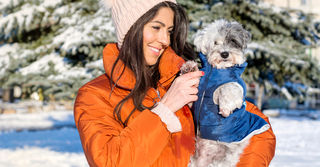Animal Behavior
Why Some People Think of Pets Like Children and Others Don't
A recent study investigates the rise of “interspecies families.”
Posted March 27, 2019 Reviewed by Lybi Ma

In recent years, the relationship between humans and their pets has been changing. To wit, people increasingly see their pets (i.e., cats and dogs) as core family members. This shift makes sense when you consider the myriad ways that the American family has changed since the 1950s.
Of particular note, marriage rates have been eroding, as people remain single, unmarried, or choose to cohabitate. Moreover, people delay marriage. There has also been a marked rise of childfree women, as well as an increase of non-traditional family structures. According to recent research, these various factors have not only paved the way to new definitions of family and parenthood, but they have also allowed humans to have deeper relationships with animals. Welcome to the 21st century and interspecies families.
How do people who identify as pet parents make sense of and describe their roles in relation to their pets? This was the focus of a study conducted by researchers Nicole Owens and Liz Grauerholz. Many in the larger culture—and academia—have relegated the phenomenon of pet parenting and the rise of the fur baby to the province of childless adults. This view, the authors maintain, misses the complexity and depth of the human-animal relationship. It also delegitimizes this form of a non-traditional family.
To investigate the psyche of the pet parent, Owens and Grauerholz began by recruiting participants for their study. In the final tally, the sample was mostly white with 28 percent identifying as Hispanic/Latino. In terms of marital status, 46 percent were single, 44 percent were married, and 8 percent were divorced or widowed. Fifty-six percent were women, and 46 percent were parents of (human) children. The average household income was $76,000 U.S., and the average age was 36.6 years. Most of the participants had dogs only (59 percent), or both cats and dogs (39 percent), while 18 percent lived with just cats.
One of the researchers (Owens) interviewed participants in their own homes, using an interview which was organized around nine open-ended questions. Some questions explored the nature of the human-animal relationship, such as, “Tell me about how/when you realized you considered your companion animal a family member.”
The questions also delved into whether these relationship dynamics were in keeping with human parenting, like, “Do you consider yourself a parent [to your pet]? If yes, describe your parenting style.” Other questions held companion animals and human children in parallel: “As a mother of human children, how does parenting compare to your relationship with your companion animal?” The interviews were then examined and coded for themes.
The results were striking. There were two major revelations about those who did not consider themselves pet parents:
1. Roughly 20 percent of the participants firmly did not see themselves as pet parents, and approximately 15 percent only somewhat felt themselves to be pet parents. Of this non-pet parent group, it was mostly men who felt that they were not pet parents, though they did feel that their pets were family members. Two-thirds of these non-pet parents were parents of humans.
These participants used an array of descriptors to describe their relationship with their pet, including “roommate,” “caretaker,” “friend,” “companion,” and quite remarkably “the one that can pour the food for them.” Despite using language that they could apply to parent a human child, such as “taken care of them and nurtured them and watched them grow up,” the non-pet parents in this study did not embrace the term parent, dad, or mom.
2. Many of the participants who did not identify as pet parents were engaged in the animal rights movement, which maintains that keeping a pet for the sake of human happiness is immoral because it essentially reduces animals to things. From this perspective, animals have agency and will, and thus these participants felt for philosophical reasons that they should not assume ownership or a parental role. One participant expressed:
"I don’t consider saying I am a father as it gives some entitlement over pets. I hate it when people say they are the owner of an animal because you don’t really own it. It is rather a part of your life, a companion. I don’t like the connotation. I am more of a caretaker. We just share each other’s lives, and I provide for them. That’s how I see it. I just have a different view. Most people think about it in a way that they own that animal. I don’t see it that way, though. That just means that you come first. If he bites or scratches me, I look at it from the point that I annoyed him. He was letting me know that he does not want me to do that anymore.”
Participants who identified themselves as pet parents saw their roles in relation to their pets differently, and they varied depending on whether or not they had human children—and the age of their human children. There were three major findings:
1. Pet parents without children borrowed heavily from broader cultural narratives surrounding parenting in constructing their relationship with their pet. Since the language around pet parenting is less developed than that of human parenting, the researchers contend that using this more established language might lend more parental “legitimacy” for pet parents.
Pet parents also highlighted the importance of teaching in their relationship with their pet, much like a parent of a human child. As one participant explained:
"I don’t want Max (her dog) to misbehave while we’re doing this interview, and so I know I planned to have things in advance to distract him as if you’re distracting a child . . . because I don’t want him to jump on you. We’re still training him. He still doesn’t know a lot of things. We’re still trying to get him to not jump on people and biting.”
At the same time, many childless pet parents in this study planned on having human children in the future and viewed pet parenting as a form of training and practice for this upcoming event.
Schooling their pets was also a salient feature for pet parents. As one participant remarked: “Yeah, I’m his dad, definitely. I mean, I take care of him, whatever he needs. Take him to the doctor, feed him, water, let him out. If there was a cat school, I’d take him there.”
2. Parents of younger children described their experiences of pet parenting in terms of the differences between parenting pets versus children. Many reported that parenting pets helped prepare them for having human children, often comparing their experiences of parenting in terms of before and after having children. As one participant reflected: “. . . it’s so much more involved than having a pet. Your pet can give you love, but they don’t understand everything that you need to do to raise a child . . . It’s a totally different dynamic.”
Participants also expressed guilt about how their relationship with their pet changed after they had children, describing how they don’t have the same level of time, energy, and work. Another participant explained:
“It takes so much of my time and energy, and I think the cats know that, and there have been times where I have felt bad, because I felt, look, I’m so tired by the end of the day or during the day when the two little ones are napping and Alexander’s in school that I just want to sit in quiet for a few seconds, and then they come to me. I feel like they need love because they haven’t got much time and attention from me or Rick [husband] or whatever, and I feel bad, and I try to love them, and that’s why we try to make nighttime as much about the cats as we can.”
In interspecies families, participants admitted that the value and/or treatment towards their pets changed after human children arrived. This speaks to a concept known as “flexible personhood,” in which treatment and regard shifts as a result of changes in circumstances. As one participant put things, “He [dog] wasn’t getting enough attention. I felt so guilty. I was so busy with the baby, but he is a dog. He can for a while be by himself.”
3. Parents of older human children described parenting in terms of the similarities between children and pets. They also described caring for their pets emotionally and physically with joy. When one participant was asked whether she parented her dog differently than she parented her son, she said, “No. I told Elliot [her son], ‘We spoil the dog just like we spoiled you.’ I said, ‘We never left you alone, and we never left the dog alone.’”
Of note, pet parents of older children characterized their role differently than childless pet parents, as they did not talk about training or disciplining their pets. And unlike pet parents of younger children, the pet parents of older children did not highlight the differences between parenting young children and pets. Given this group’s emphasis on mutual care and joy, the authors suggest that perhaps it is this group that finds being a pet parent and part of an interspecies family most rewarding.
References
Interspecies Parenting: How Pet Parents Construct Their Roles. Nicole Owens and Liz Grauerholz. Humanity & Society 1-24. 2018.




